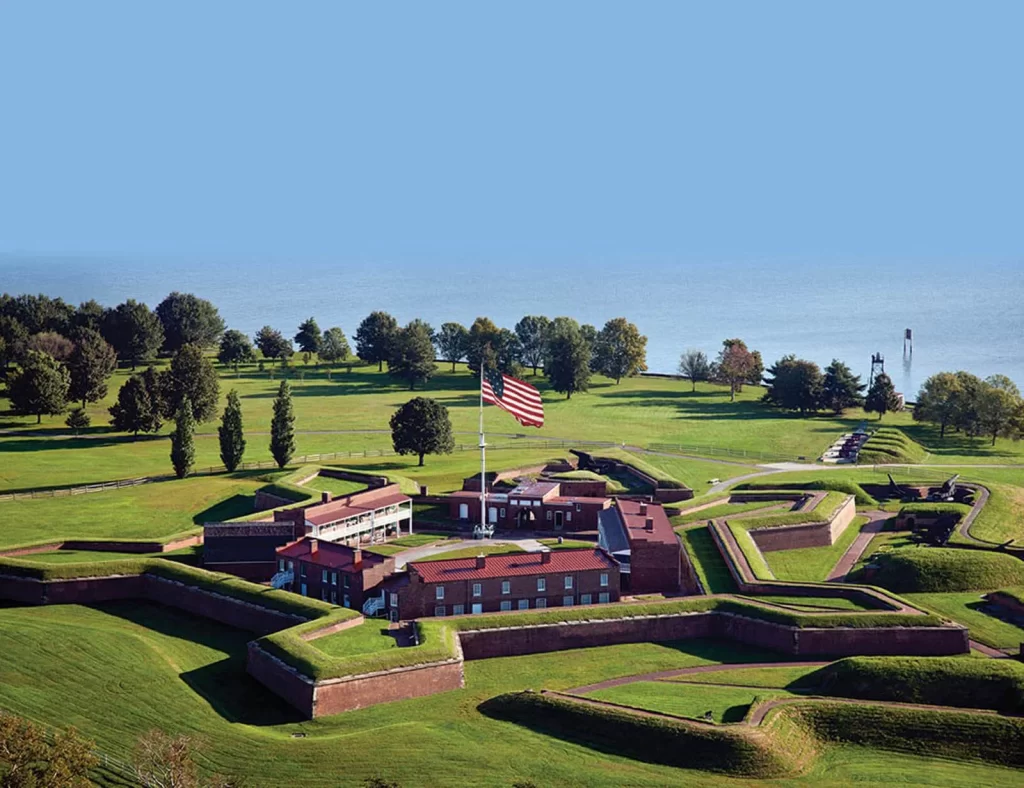Introduction
Fort McHenry in Baltimore, MD, symbolizes American defence. The fort was constructed in 1798 and saw action throughout the War of 1812. During the Battle of Baltimore, its defence inspired Francis Scott Key to write “The Star-Spangled Banner.” Fort McHenry is now a national monument and a historic shrine to the spirit of American resilience, born from freedom.
Historical Background
By the end of the 18th Century, Baltimore was an expanding city and especially vulnerable to attacks. While tensions with Britain increased, the need for an adequate defence system was essential. Guarding a harbour whose only other protection was within the city, Fort McHenry had been intended from its inception to defend both it and Baltimore. Named for James McHenry, a respected surgeon and statesman, the fort quickly grew in importance as an East Coast defensive position.
Its star-shaped, bastioned pentagon form meant the fort was also designed to battle bombardments. Made up of curves, its design delivered a commanding tactical edge as defenders were able to cover virtually every attacking angle. Built as a critical fort and naval base to guard Baltimore, Fort McHenry was of prophetic importance during the War of 1812.
The Battle of Baltimore and the British Assault
Fort McHenry, in its history, was the most critical event that happened during the War of 1812, which took place in September 1814. Next, the British moved on to Baltimore following their success in Washington, D.C. It sparked a brutal naval and land offensive, which led to the Battle of Baltimore. Looking to weaken the American defence, the British fleet bombarded Fort McHenry for 25 hours.
The American garrison at Fort McHenry was held under the command of Major George Armistead. The fort didn’t surrender despite so much bombardment happening. The American forces drew into the fort with sufficient men; meanwhile, a few British cannonballs penetrated deep into the residence walls. The British were unable to capture Baltimore, and it turned the tide of battles in the War of 1812.
Francis Scott Key and the National Anthem
The historic moment connecting Fort McHenry with””The Star Spangled Banne”” is one of thesite’ss most visible legacies. Lawyer and poet Francis Scott Key was on a British boat hoping to arrange the freedom of an American prisoner during the bombardment. Key watched the constant bombardment of the fort from his ship. He watched through the night, nervously observing as they fought on, and he wondered if it would hold.
At dawn, Key saw the American flag still flying over Fort McHenry. The sight touched him and inspired him to write a poem, originally titled “Defense of FortM’Henryy” This poem eventually became known as “The Star-Spangled Banner” and, ultimately, the U.S. National Anthem. The flag that Key had seen, known as the “Great Garrison Flag“, evolved into an icon of American strength and optimism.
The Fort’s Strategic Importance Beyond the War of 1812
While coastal forts became almost obsolete after the War of 1812, Fort McHenry continued piecemeal service in later wars. The fort was used as a prison for Confederate soldiers and political prisoners by the Union during part of the Civil War. It kept its strategic location, protecting Baltimore’s harbour in times of stress.
The fort eventually had a role in World War I when it was converted into a military hospital for returning American soldiers. And it added to the lore of U.S. army history, endlessly reinforcing its importance in American mythic memory. By the mid-20th century, the fort ceased most military operations; consequently, it soon became a recognized historical site.
A National Monument and Historic Shrine
The park was transferred from the War Department to the National Park Service in 1933. People from around the country visit to soak in its rich past and wander through its immaculately maintained spaces. Fort McHenry is the only national monument in the United States to hold this combination of designations.
Every year, on the fort, thousands hear its place in undeveloped history. Tour the bastions, barracks and interiors of this fort in Baltimore. Historical reenactments and educational programs actively bring the past to life, helping us understand the lives of soldiers defending their fort. The park also provides flag-raising ceremonies, enabling visitors to enjoy the grandeur of “The Star-Spangled Banner.”
Keeping History and Legacy
Fort McHenry is a symbol of the courage that built this nation. But the fort’s most lasting legacy is its defence of Baltimore and that it inspired the national anthem. It remains a site of reflection, patriotism, and instruction in the present day.
These efforts will help preserve the site for generations of people who will get there after this generation is gone. The NPS preserves both the fort and its artefacts, including the flag flown during the pivotal Battle of Baltimore. The spirit of that day still haunts Fort McHenry, a reminder of the nation’s past agonies and triumphs.

